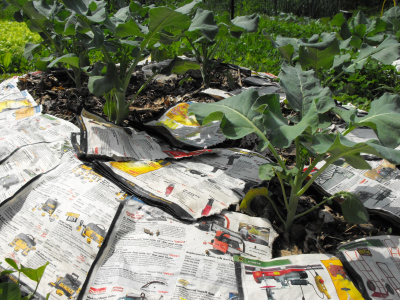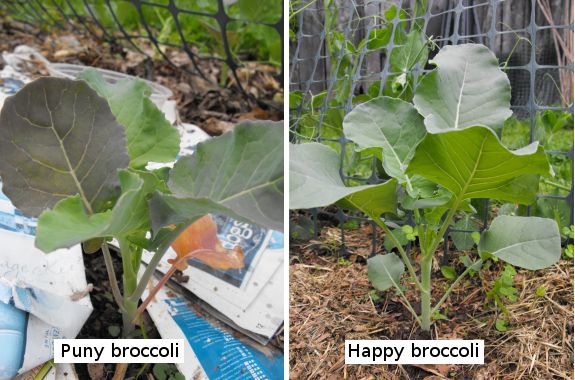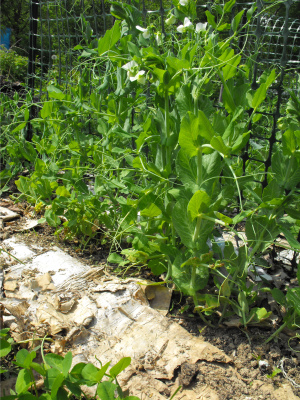
Summer mulch conclusions
 The
last experiment I want to talk about this week is our summer
mulch experiment.
You'll remember that I've been testing out lots of different mulches
this spring, including grass clippings, autumn leaves, newspaper, and
cardboard. How are they doing a month later?
The
last experiment I want to talk about this week is our summer
mulch experiment.
You'll remember that I've been testing out lots of different mulches
this spring, including grass clippings, autumn leaves, newspaper, and
cardboard. How are they doing a month later?
When I laid down the
mulches, I was hoping I could put them directly on top of small weeds
rather than taking the time to weed each bed before I mulched it.
Newspaper and cardboard did an admirable job of smothering the weeds,
but the naughty plants grew right through the grass clippings and
autumn leaves. In the case of the former, I couldn't even tell
that the bed had been mulched a month later and just weeded as usual,
but it was quite difficult to pull weeds from the autumn leaf mulched
beds without taking half the mulch away with them.
I was a bit concerned
that mulches with a high C:N ratio would retard the growth of
my plants by locking up nitrogen in the soil, and three of our pea beds
do seem to have some
problems. Rather than growing lush and green, the peas are
yellowing at the base and barely growing. Interspersed broccoli
is huge and luxuriant in some beds, but puny and purple-tinged in
others.

But is there a
correlation between mulch and plant health? I can't be
sure. All three of the sad-looking beds were mulched with a
combination of paper with colored ink and autumn leaves, but some
similarly mulched beds are fine. My best guess is that the puny
plants are reacting to something in glossy paper, but I didn't keep
records of which beds got glossy and which didn't, and the paper has
decomposed enough that gloss is no longer visible. It's also
quite possible that some non-mulch-related variable is at work, but
I'll play it safe and keep glossy paper away from my plants in the
future.
 Although
the grass clippings didn't do much for weed control on already weedy
beds, they did keep weed-free beds from growing new weeds. In
addition, the grass clippings seemed to work as a light fertilizer,
resulting in plants that were big and healthy. If I have time to
weed first (and enough grass clippings to go around), grass mulch seems
to be a winner.
Although
the grass clippings didn't do much for weed control on already weedy
beds, they did keep weed-free beds from growing new weeds. In
addition, the grass clippings seemed to work as a light fertilizer,
resulting in plants that were big and healthy. If I have time to
weed first (and enough grass clippings to go around), grass mulch seems
to be a winner.
I only mulched one bed
with cardboard, but this mulch seems to be a winner as well ---
cardboard is a great weed retardant, has no ill effects on plants, and
doesn't blow around the way paper did for the first few days before it
melded to the soil. I'm not surprised since I learned in Steve
Solomon's book that
corrugated cardboard has a C:N ratio comparable to straw rather than to
paper due to the nitrogen in the glue. I'm mulching several more
beds with cardboard this week and will give you an update in a month or
two on positives and negatives.
| This post is part of our Farm Experiments lunchtime series.
Read all of the entries: |
Want more in-depth information? Browse through our books.
Or explore more posts by date or by subject.
About us: Anna Hess and Mark Hamilton spent over a decade living self-sufficiently in the mountains of Virginia before moving north to start over from scratch in the foothills of Ohio. They've experimented with permaculture, no-till gardening, trailersteading, home-based microbusinesses and much more, writing about their adventures in both blogs and books.
Want to be notified when new comments are posted on this page? Click on the RSS button after you add a comment to subscribe to the comment feed, or simply check the box beside "email replies to me" while writing your comment.

I'm using a combination of newspaper and hay in my garden this year. I don't use glossy paper, I had known already that it was not good for mulch. The hay concerns me a little, as to the seeds in it, but I'm hoping that the thickness of the mulch will do the job anyhow.
I've used grass clipping before, however those were in my blueberries. The biggest problem I had with that was the surface dried and became slightly water repellent. It did not help my blueberries, but then again, NOTHING helped them. I lost all 40 bushes though I tried everything in the book to save them. I think the soil is not the best for them in that location.
Great info on this post!~ Thanks!
~Faith
I supposedly knew glossy paper was bad, but it's awfully hard for me to throw anything away and that glossy paper needed a home. Next time, I'll really know better.
Next time, I'll really know better.
I've noticed when using weedy mulch or compost that all's well as long as the mulch stays in place. It's only if you have to rake back the mulch to let a small seed germinate that you get into trouble. As long as you use transplants in the hay mulch area, you should be fine! Some people let it compost for a year to kill the seeds, I think.
Forty bushes lost! That breaks my heart! Our dozen are doing well now that I bit the bullet and bought the chemical acidifier. Our soil is just too alkaline for them otherwise. You might try the grass clippings on your vegetable garden, spreading it no thicker than two inches or so. At that thickness, it'll melt in and shouldn't repel any water.